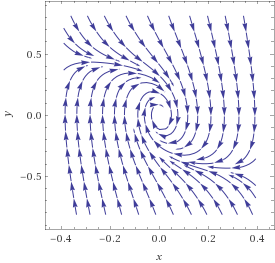I was trying to find the famous attractor solution of the inflaton field which follows the equation
$$\frac{d\dot{\phi}}{d\phi}=-\frac{\sqrt{12\pi}(\dot{\phi}^2+m^2\phi^2)^{1/2}\dot{\phi}+m^2\phi}{\dot{\phi}}$$
in ''Physical Foundations of Cosmology by Viatcheslav Mukhanov'' the author claims the equation can be studied using the phase diagram method and the behavior of the solutions in the $\phi$-$\dot{\phi}$ plane is shown in Figure 5.3
How does one reached such a plot? I tried solving the differential equation using Wolfram Mathematica but it couldn't generate a single point.





